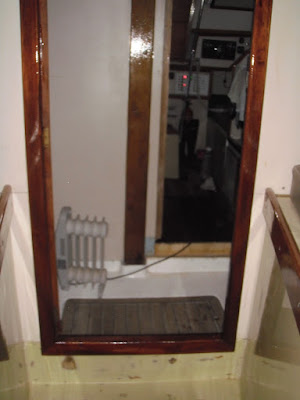New Morning has not been totally neglected since my last post I have been pottering about doing odd maintenance jobs but recently I became motivated to finish off the heads door frames. Since this involved making up four arch section pieces of architrave to suit the original doors I had been putting off starting the job, however I decided that it was time to get on and get them finished. I started by making the four arch sections these are made from six pieces dowelled and glued together before being cut to shape with a jig saw and sanding.
Thursday, 30 December 2021
Door frames
Friday, 8 October 2021
About time I wrote something
Over the past few months I have not done an awful lot on New Morning mostly cleaning and maintenance work the usual general stuff not really a lot to write about. However I have done a couple of bits and pieces which I will include in one post.
I managed some sailing this year with a couple of trips across the Thames estuary, the first in July to the Colne and the Blackwater and in September to the Roach and then up the Crouch to Fambridge otherwise it has been a case of pottering in the Swale. The first job I carried out was as a result of the trip to the Colne, and after spending the night at anchor and then raising and stowing the said anchor I decided that the 35lb CQR anchor was going, I had already thought seriously about it on previous trips it was extremely awkward too deploy and recover especially through the gap between the forestay and the pulpit so after this trip I decided that it had definitely got to go, After some research looking at selection charts I decided that a 22lb Delta would be adequate which was duly obtained from Cactus Marine who had a special offer on them.
Friday, 2 July 2021
Spinnaker Pole
It has been quite some time since I last posted so I thought that I had better do something about it, up to this week I haven't done a great deal what with the pandemic, yes I know we are all using that excuse, and the cold wet weather. Last week I finished scraping the bottom and got the antifouling on ready for relaunching on the following Monday which all went well the rest of this week has been spent putting things back together, filling water tanks etc. Next week I am aiming to service the engine and put the sails back on.
During the last lockdown there wasn't a lot I could do but I did have a look at the spinnaker pole which had been sitting at home since I bought New Morning. I knew that the sliding bolts in the pole ends were seized so I thought that I would use the time to try and sort them out. The ends were each retained with three self tapping screws which proved reasonably easy to remove given that they were stainless into aluminium. When I removed the ends I found that the bolts were fitted into a plastic sleeve and were seized solid in fact the only way to remove them was to completely butcher the sleeves I am not sure if it was a build up of crud or the plastic sleeves had soaked up water and swelled which some plastics particularly nylon are are prone to. I started looking around for a pair of new pole ends these needed to have a 40mm diameter spigot to fit into the hollow aluminium pole but this size seemed to be unavailable yes I could have bought a larger pair and turned them down to fit. Of course the next problem was the price they were for a boat after all, £48 each was about the best that I could find time for a plan 'B' especially as I usually sail single handed so don't get that much use out of the spinnaker although I have been known to pole out the genoa on my previous boat. I decided to make some new plastic sleeves and went to my favourite engineering plastics supplier at www.directplastics.co.uk and purchased a length of 30mm diameter Acetal rod 500mm long. This material is ideal for this application as it is not known for swelling when wet it is also easy to machine the swarf coming away easily, with some plastics it can wind itself tightly round the bar as it turns it also provides a good bearing surface. I have used this company on several occasions they have a reasonable minimum order policy and the price was reasonable £10.48 inc VAT. Delrin would also have been suitable having similar properties but it is a little more expensive.

















